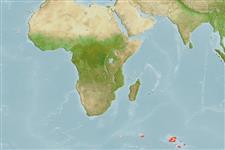Environment: milieu / climate zone / depth range / distribution range
Écologie
marin démersal; profondeur 0 - 91 m (Ref. 11892). Polar; 46°S - 54°S
Southern Ocean: Kerguelen and Crozet Islands; littoral and deeper waters of Heard Island.
Taille / Poids / Âge
Maturity: Lm ? range ? - ? cm
Max length : 8.2 cm TL mâle / non sexé; (Ref. 11892)
Description synthétique
Clés d'identification | Morphologie | Morphométrie
Épines dorsales (Total) : 3 - 5; Rayons mous dorsaux (Total) : 21 - 24; Rayons mous anaux: 15 - 19.
Found under rocks on the beach or in tide pools, but may also be found deeper (down to 80 m) among kelp and other algae (Ref. 5191). Feed on small crustaceans and common in littoral of all sub-Antarctic islands (Ref. 42041).
Life cycle and mating behavior
Maturité | Reproduction | Frai | Œufs | Fécondité | Larves
Hureau, J.-C., 1990. Harpagiferidae. p. 357-363. In O. Gon and P.C. Heemstra (eds.) Fishes of the Southern Ocean. J.L.B. Smith Institute of Ichthyology, Grahamstown, South Africa. 462 p. (Ref. 5191)
Statut dans la liste rouge de l'IUCN (Ref. 130435: Version 2024-2)
Menace pour l'homme
Harmless
Utilisations par l'homme
Outils
Articles particuliers
Télécharger en XML
Sources Internet
Estimates based on models
Preferred temperature (Ref.
123201): 2.9 - 3.8, mean 3.2 °C (based on 18 cells).
Phylogenetic diversity index (Ref.
82804): PD
50 = 0.5010 [Uniqueness, from 0.5 = low to 2.0 = high].
Bayesian length-weight: a=0.00525 (0.00206 - 0.01336), b=3.10 (2.88 - 3.32), in cm total length, based on LWR estimates for this (Sub)family-body shape (Ref.
93245).
Niveau trophique (Ref.
69278): 3.2 ±0.5 se; based on size and trophs of closest relatives
Résilience (Ref.
120179): Milieu, temps minimum de doublement de population : 1,4 à 4,4 années (Preliminary K or Fecundity.).
Fishing Vulnerability (Ref.
59153): Low vulnerability (10 of 100).
